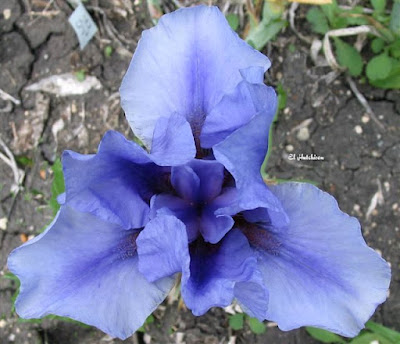By Griff Crump
Over the years, in observing seedlings, I gradually began to suspect that color in irises, and, particularly, the intensity of color, is not due entirely to pigment, but is also affected by the texture of the flower’s petals. If I were trained in the physical sciences, which I am not, I might have come to such a conclusion sooner. A recent article in the Smithsonian magazine, entitled “Why Are Some Feathers Blue?” tends to confirm my suspicion:
“For decades, scientists have known how birds with yellow or red feathers usually get their color: It comes from pigments in foods the birds eat. Flamingoes, for instance, extract pink pigments from algae and crustaceans they filter out of the water. The challenge has been to figure out exactly how blue birds get their color. It can’t be their diet: blue pigments, like those in blueberries, are destroyed when birds digest them. . .
 |
| Getty Images / Minden Pictures RM |
“Richard Prum, an ornithologist at Yale, discovered that birds make blue feathers in a different way. . .
“Prum discovered that as a blue feather grows, something amazing happens. Inside each cell, stringy keratin molecules separate from water, like oil from vinegar. When the cell dies, the water dries away and is replaced by air, leaving a structure of keratin protein interspersed with air pockets, like a sponge or a box of spaghetti. When white light strikes a blue feather, the keratin pattern causes red and yellow wavelengths to cancel each other out, while blue wavelengths of light reinforce and amplify one another and reflect back to the beholder’s eye. The result: blue, an example of what scientists call a structural color (as opposed to a pigmented color) because it’s generated by light interacting with a feather’s 3-D arrangement. And different shapes and sizes of these air pockets and keratin make different shades of blue.”
Blue, in irises, is produced by the presence of anthocyanin, a pigment, not air pockets. But the article shows that the interplay of light and structure affects the eye’s perception of color. It’s been my thinking that the way we perceive certain aspects of the coloration of irises, such as shading and intensity, is also affected by that interplay.
In the case of the seedlings that I have observed over the years, it happens that, in most cases, the color is red. The first seedling that caught my interest in this regard was 985R4, a bee cross on 953P (Holy Night X 93RR2 (Margarita x Momauguin)).
 |
| 985R4 |
Whatever is causing that effect, it was transmitted to 985R4's progeny, 062X27 (985R4 X Cherry Glen), but to a lesser degree. And, in 062X27, we also see what we call “diamond dust” pr sparkles on the petals.
 |
| 062X27 |
‘Prince Igor’, whose too-lengthy-for-here pedigree is unrelated to 985R4 (as far as we know – but what may 985R4's bee know?), also has a sheen.
 |
| 'Prince Igor' Crump, 2009. |
Switching, now, to blues and blue/blacks, I find the sheen in 072O1 (Stealth Fighter X Ranks of Blue)
 |
| 072O1 |
and, to a lesser extent, in its sibling 072O22, which also displays “diamond dust”.
 |
| 072022 |
Another 'Stealth Fighter' derivative, 09S12 (Stealth Fighter X Holy Cow), shows pronounced sheen, top and bottom, in a very ruffled flower.
 |
| 09S12 |
 |
| 'That Certain Something' Crump, 2008 |
As with 985R4 and 'Stealth Fighter', above, ‘That Certain Something’ also imparts its softer tone to its progeny, as in the case of seedling 042F3.
 |
| 042F3 |
So something may be going on in the way that we perceive color in irises. I suspect something similar is at work with irises which appear to change color during the day. If I’m correct, a reader with a greater degree of scientific knowledge may say, “Well, anybody who didn’t flunk physics should know that!” But I’m willing to suffer the slings and arrows in order to broach the discussion, because, when we know how something works, we can begin to manipulate it.
Does anyone else see it this way?



































